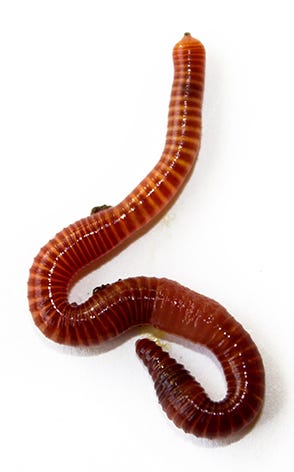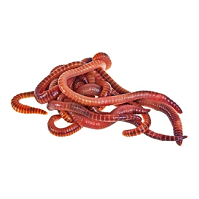Obtain one of the most Out of Your Compost With Red Wigglers
The combination of red wigglers right into your composting system can dramatically enhance the effectiveness and performance of waste management techniques. These worms are not just proficient at breaking down organic materials yet also add to the creation of top quality garden compost that enriches dirt wellness.
Recognizing Red Wigglers
Comprehending red wigglers is crucial for anyone thinking about vermicomposting, as these worms play an essential duty in damaging down raw material. Scientifically referred to as Eisenia fetida, red wigglers are differentiated by their reddish-brown shade and slim bodies, commonly gauging between 3 to 4 inches in size. Unlike earthworms, which thrive in soil, red wigglers choose a damp, organic-rich atmosphere, making them suitable for composting systems.
These worms are renowned for their starved hunger, taking in half their body weight in natural material daily. This capability allows them to quickly disintegrate cooking area scraps, lawn waste, and other naturally degradable materials, transforming them into nutrient-rich compost. Red wigglers thrive in temperature levels varying from 55 ° F to 77 ° F, demanding mindful surveillance of their environment to ensure optimum activity.
Furthermore, red wigglers duplicate swiftly, increasing their populace around every 3 to 4 weeks under perfect problems. This rapid recreation is important for preserving an effective composting operation. red wigglers. Recognizing their biology and habits is important for anybody wanting to harness their potential in lasting waste monitoring methods
Advantages of Vermicomposting
Vermicomposting offers various advantages that expand beyond straightforward waste decrease. This innovative method leverages the natural disintegration capacities of red wigglers to change organic waste into nutrient-rich compost, boosting soil health and wellness and fertility. The resulting vermicompost is brimming with advantageous microbes, which can enhance soil framework and increase vitamins and mineral accessibility for plants.

Additionally, vermicomposting can be exercised in different settings, making it accessible for city occupants and those with restricted outside area. It needs very little financial investment and can be conveniently taken care of inside your home or outdoors, making it appropriate for various lifestyles.
Making use of vermicompost also promotes much healthier plant development by improving microbial activity, improving water retention, and giving vital nutrients. Gardeners and farmers that integrate vermicompost right into their methods commonly observe boosted crop returns, making vermicomposting a sustainable selection for both waste management and Web Site farming performance.
Establishing Up Your Worm Bin
Developing a reliable worm bin is essential for effective vermicomposting, and with just a couple of essential parts, anybody can develop an efficient system. Start with an appropriate container; a plastic or wooden container with a cover functions well. Ideally, the bin should be between 10 to 18 inches deep to supply adequate area for the worms to grow.
Guarantee correct ventilation by piercing small holes in the sides and cover, permitting air flow while retaining wetness. Maintain a balance in between dampness and water drainage; the container must be moist yet not soaked. A layer of bed linens, such as shredded newspaper or cardboard, supplies a habitat for the worms and help in dampness retention.
Think about the place of your worm container. A temperature series of 55 to 77 levels Fahrenheit is perfect, so maintaining the container inside your home or in a shaded outdoor location can aid preserve regular problems. Frequently monitor the bin for odors, which show a discrepancy, and readjust wetness degrees as needed. By following these guidelines, you will certainly create a conducive setting for red wigglers, laying the foundation for an effective vermicomposting endeavor.
Feeding Your Red Wigglers

Prevent feeding them meat, dairy products, and oily foods, as these can bring in bugs and create unpleasant smells. Additionally, it is essential to chop or shred bigger products to facilitate quicker disintegration, ensuring your worms can access the nutrients much more efficiently.
Small amounts is important; overfeeding can bring about anaerobic conditions, harming the worms and reducing down the composting process. Display the container for leftover food and readjust your feeding program as necessary. A general policy is to provide regarding half a pound of food per extra pound of worms per week.
Finally, maintaining wetness is crucial. Objective for a moist, yet not soaked, setting, as moisture help in the break down of food and sustains worm activity. By thoroughly managing their diet regimen, you can enhance the performance of your red wigglers in transforming natural waste into rich garden compost.
(red wigglers for sale near me)
Harvesting and Utilizing Garden Compost
After numerous weeks of persistent composting, you will certainly observe that the rich, dark material generated by your red wigglers is all set for harvest. One reliable technique is to utilize a light source; red wigglers are sensitive to light and will tunnel much deeper into the material, permitting you to scoop out the leading layer of garden compost.
Once collected, the garden compost can be used in numerous applications. Mix it right into yard dirt to enhance framework and fertility, or utilize it as a leading clothing for potted plants.
Bear in mind to keep any type of extra compost in a trendy, completely dry location to keep its quality. By successfully harvesting and using the garden compost generated by red wigglers, you not just enrich your yard but additionally promote lasting gardening practices.
Verdict
Including red wigglers into composting techniques considerably boosts the efficiency of organic waste change. Eventually, the combination of red wigglers in composting adds to lasting horticulture, lowers land fill waste, and advertises ecological stewardship via reliable source recycling.